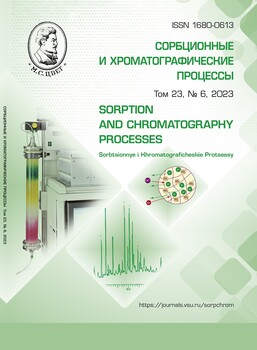Mass spectrometric analysis of plant protein concentrates
Abstract
The work is devoted to the study of the composition of protein concentrates from amaranth grains (Amaranthus hypochondriacus L.), Voronezh variety. Amaranth protein concentrates were obtained by the alkaline extraction of proteins, the neutralization of the solution, followed by ultrafiltration; by separating the starch fraction with amylolytic enzymes; alkaline extraction of proteins and their precipitation at pH 4.5. The conditions for protein extraction were selected, followed by gas chromatography-mass spectrometric analysis and their identification. It has been shown that proteins from amaranth grain were more efficiently extracted with a buffer containing urea at protein concentrations in solution of 1.7, 1.9, and 2.9 mg/cm3respectively, while the buffer with detergents was more effective for the extraction of low molecular weight proteins at protein concentrations in solution of 4.9, 2.9, and 9.0 mg/cm3 respectively. As a result of HPLC-MS/MS analysis followed by a search and identification in the UNIPROT database, it was established that the main protein of amaranth grain is 11S-globulin, which is a reserve protein of amaranth seeds. In amaranth concentrates, 14 unique proteins characteristic only for A.hipochondriacus L., as well as proteins that were not characteristic to this species, but were reliably identified. Based on the results of semi-quantitative analysis of the peptide profile of amaranth grain protein concentrates, a high frequency of occurrence of the main 11S-globulin proteins was established in all samples. The frequency of occurrence of other proteins in samples obtained by different methods differed significantly, which was associated with the peculiarities of protein isolation from amaranth grain. The obtained results can be used for the production of plant protein concentrates with a set protein composition.
Downloads
References
Kondaurov S.Y., Artemova I.I., Nikisheva M.I., Kruchinin M.M., Shajhutdinov A.Z., Zolotovskij B.P., Pilotnye ispytaniya processa adsorbcionnoj osushki i otbenzinivaniya prirodnogo gaza na rossijskih adsorbentah, Gazovaya promyshlennost', 2011; 12: 26-29.
Temerdashev Z.А., Rudenko A.V., Kolychev I.A., Kostina A.S., Effect of alumosilicate adsorbent regeneration conditions on the dehydration of methanol extracted from natural gas, Ecology and industry of Russia, 2020; 24(8): 17-21. https://doi.org/10.18412/1816-0395-2020-8-17-21
Khaleel A., Methanol dehydration to dimethyl ether over highly porous xerogel alumina catalyst: Flow rate effect, Fuel Process. Technol., 2010; 91(11): 1505-1509. https://doi.org/10.1016/j.fuproc.2010.05.028
Catizzone E., Migliori M., Aloise A., Lamberti R., Giordano G., Hierarchical low Si/Al ratio ferrierite zeolite by sequential postsynthesis treatment: catalytic assessment in dehydration reaction of methanol, J. Chem., 2019; 2019: 1-9. https://doi.org/10.1155/2019/3084356
Rashidi H., Hamoule T., Reza Khosravi Nikou M., Shariati A., DME synthesis over MSU‒S catalyst through methanol dehydration reaction, IJOGST, 2013; 2 (4): 67-73. https://doi.org/10.22050/ijogst.2013.4797
Temerdashev Z.А., Kostina A.S., Rudenko A.V., Kolychev I.A., Vasil'ev A.M., Catalytic activity of alumina–modified silica gels in methanol conversion to dimethyl ether, Russian J. оf Appl. Chem., 2021; 94(5): 576-585. https://doi.org/10.1134/S1070427221050049
Macina D., Piwowarska Z., Tarach K., Góra-Marek K., Ryczkowski J., Chmielarz L., Mesoporous silica materials modified with alumina polycations as catalysts for the synthesis of dimethyl ether from methanol, Mater. Res. Bull., 2016; 74: 425-435. https://doi.org/10.1016/j.materresbull.2015.11.018
Gao S., Xu S., Wei Y., Qiao Q., Xu Z., Wu X., Zhang M., He Y., Xu S., Liu Z., Insight into the deactivation mode of methanol‒to‒olefins conversion over SAPO-34: coke, diffusion, and acidic site accessibility, J. Catal., 2018; 367: 306-314. https://doi.org/10.1016/j.jcat.2018.09.010
Wei Y., de Jongh P.E., Bonati M.L., Law D.J., Sunley G.J., de Jong K.P., Enhanced catalytic performance of zeolite ZSM-5 for conversion of methanol to dimethyl ether by combining alkaline treatment and partial activation, Appl. Catal. A-Gen., 2015; 504: 211-219. https://doi.org/10.1016/j.apcata.2014.12.027
Groen J.C., Moulijn J.A., Pérez-Ramírez J., Desilication: on the controlled generation of mesoporosity in MFI zeolites, J. Mater. Chem., 2006; 16(22): 2121-2131. https://doi.org/ 10.1039/B517510K
Fan Y., Bao X., Lin X., Shi G., Liu H., Acidity adjustment of HZSM‒5 zeolites by dealumination and realumination with steaming and citric acid treatments, J. Phys. Chem. B., 2006; 110(31): 15411-15416. https://doi.org/10.1021/jp0607566
Raoof F., Taghizadeh M., Eliassi A., Yaripour F., Effects of temperature and feed composition on catalytic dehydration of methanol to dimethyl ether over γ-alumina, Fuel, 2008; 87(13-14): 2967-2971. https://doi.org/10.1016/j.fuel.2008.03.025
Xu M., Lunsford J.H., Goodman W.D., Bhattacharyya A., Synthesis of dimethyl ether (DME) from methanol over solid–acid catalysts, Appl. Catal. A-Gen., 1997; 149(2): 289-301. https://doi.org/10.1016/S0926-860X(96)00275-X
Temerdashev Z.А., Kostina A.S., Ryadno E.G., Vasil'ev A.M., Vasil'eva L.V., Kolychev I.A., Life cycle of silica gel adsorbents used in natural-gas purification, Protection of metals and physical chemistry of surfaces, 2022; 58(4): 696-701. https://doi.org/10.1134/S2070205122040232
Bateni H., Able C., Development of heterogeneous catalysts for dehydration of methanol to dimethyl ether: a review, Catal. Ind., 2019; 11(1): 7-33. https://doi.org/10.1134/S2070050419010045
Chukin G.D. Himiya poverhnosti i stroenie dispersnogo kremnezyoma. M., Paladin, Printa Publ., 2008, 172 p. (In Russ.)
Bellami L. Infrakrasnye spektry slozhnyh molekul. M., Izdatel'stvo inostrannoj literatury, 1963, 590 p. (In Russ.)







